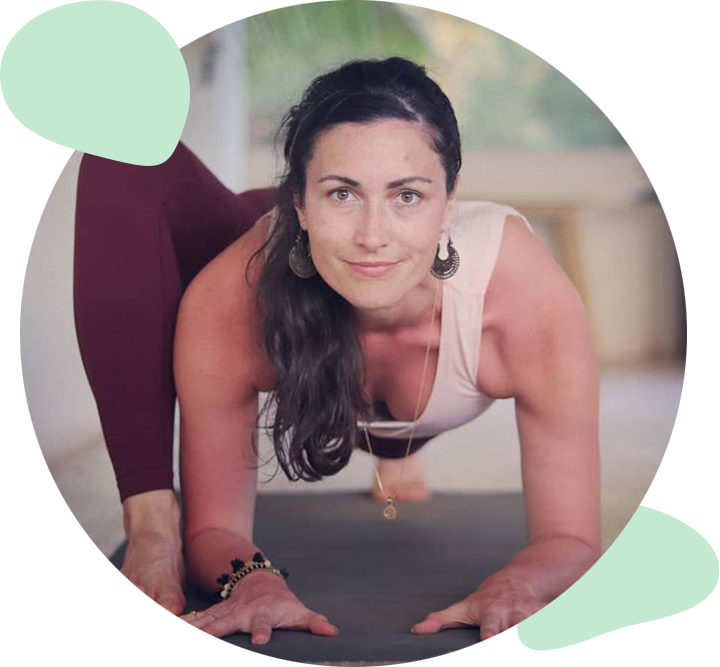Meditation : a beginners guide
Meditating can be fascinating for those who don’t practice; one might think that nothing is happening at first glance. However practitioners can’t stop praising how impactful and beneficial it is. Before I started doing yoga I was having a hard time getting the ins and outs of meditation. Standing still with your eyes closed for minutes… they say relaxation but all I see is boredom, and boredom gets on my nerves. What are we supposed to think about whilst meditating?
Active and dynamic meditation: yang yoga
When I first started practicing a physical type of yoga (asana), it was so hard that, in order to stay focused, I had to stop thinking and empty my mind; be present and keep my mind still in order to keep my body still. And while this mental gymnastic is triggered by a physical practice, this is indeed a type of meditation! The physical aspect is only helping us channel our thoughts to enable stillness of the mind. That's why we feel so relaxed and calm during savasana after a good dynamic practice. This is in my opinion the easiest way to reach a meditative state.
Active and static meditation: yin yoga
The first time I attended a yin yoga class, I found it deadly boring. Being fairly flexible, I can get into pretty much all the yin postures without difficulty. So what's the point of not moving? Later on I understood that it’s not the aim of yin yoga. Of course it’s important to get into a good position in order not to injure yourself, but the aim isn’t to find the perfect alignment - instagram like. The idea behind a yin practice is to surrender to the posture and welcome discomfort, breath into the difficulty and above all resist the temptation to escape from a challenging posture, whether it’s by moving physically or moving your mind away - distracting yourself - from what’s happening in your body. Once I understood this, I found yin yoga really challenging but then also the type of yoga I needed the most given I can’t stop moving and thinking all the time.
Recently during a yin yoga class, the teacher asked us to try and stay focused on present, even though it was potentially uncomfortable. She then invited us to observe our mind and what it wanted to do; we always tend to start thinking about the future or the past when the present becomes challenging. I personally always make To Do Lists to distract me from what’s currently happening, if what’s happening is physically uncomfortable or isn’t mentally fulfilling. I found it fascinating how our mind can put strategies in place just to avoid facing discomfort. To distract us and prevent us from being present. But being able to face difficulty - analyse and accept it - is a strength. It’s a very valuable tool that we can use on and off the mat too.
Guided meditation
Meditating doesn’t always involve a physical practice. As I explained earlier, a physical practice - whether it’s dynamic or static - is only helping us to channel our thoughts. If you’re like me and you need some help to reach out a quiet and peaceful mindset but you don’t want/can’t attend an asana practice to channel your thoughts, guided meditation is a great alternative. Your guide will help you get your attention back into the present time and your body when you’ll get distracted.
PodcastsDuring my teacher training in India, Sudhir - who was teaching us yogic philosophy and meditation - guided our classes and invited us to bring our attention to our breathing and what was happening in our body. Sudhir records some of his guided meditation and publish them as podcasts on Spotify. I thoroughly recommend it : whether it’s to guide your meditation or to trigger your critical thinking, Sudhir’s podcasts are like him: interesting, kind, accessible and with a hint of humour.
When I came back from India I wanted to carry on meditating, especially in the morning when I wake up (as it’s simpler because our mind is still a bit sleepy and therefore less inclined to go all over the place) before my physical practice. First I used Sudhir’s podcasts that I broke down into 20min bits - I can’t afford nor do I have the courage - to meditate for an hour every morning like I used to do in India. But after a few weeks I kind of knew them all by heart… So I started looking for an alternative and after testing a few apps, I picked Headspace. I find this app really smart: you can pick the time you want to meditate for and it tracks your progress.
Yoga nidraAs I was testing an intro offer in a London studio I had the opportunity to test a lot of different types of yoga, some of which I wouldn’t have chosen to try otherwise (another perks of intro offers). I decided to try a yoga nidra class on a Sunday night. Yoga nidra is a passive and meditative type of yoga. The idea is to try and remain in that very relaxing state you’re in right before falling asleep, but without actually falling asleep. It’s an hour long class during which you lie on your back. You're encouraged to get cosy and use props such as bolsters and covers. Lights are turned off and eyes are closed. You listen to the voice of the teacher guiding you through every part of your body, asking to picture your energy as a coloured light. At the end of the class, the teacher usually uses a chanting bowl or a gong in order to create vibrations that will round off the relaxation (I personally love vibrations, they have an incredible relaxing effect on me - but I’m also very sensitive to sounds). I find yoga nidra really efficient, as is yin yoga, and I like going to classes pretty late at night, just before going to bed. It’s important to note that yoga nidra is apparently very useful to people who suffer from insomnia because it prepares both your body and your mind to go to sleep. What you feed your mind with before falling asleep has a huge impact on your subconscious. That’s why it’s really important to keep positive thoughts at that time. And that’s also why it’s crucial to read great bedtime stories to kids before they fall asleep.
Because we don’t all have the possibility to go to yoga classes in studios, home practice - of both yoga and/or meditation - is an excellent option. Meditating doesn’t require any props, just a little bit of time and the will to take care of yourself. There isn’t any standard duration either; you can meditate for 3 minutes on the bus the same way you can meditate for 4 hours on a train. There’s gonna be an impact to your meditation practice anyway.
Personally it’s impossible for me to guide my own meditation practice and make sure my mind won’t wander around and start listing all the things I want to achieve today. That’s why I use some of the tools I’ve been taught during my training in India.
I love breathing exercises because they are super simple, they keep your mind busy just enough not to be distracted (you have to count your breaths) and they prepare your body and you mind for meditation. They help with focus, improve blood stream and renew air in your lungs. Some exercises - the most dynamic ones - can even impact digestion. I usually start with complete yogic breathing for a few minutes, then depending on days I either do a few rounds of Kapala bhaati - a type of breathing where the inhale is passive and the exhale is active - or Bhastrika pranayama, where both inhale and exhale are active. Another exercise - Naadi Shodhana or alternate nostril breathing - is very efficient to balance you breathing (inhale and exhale), quiet the mind and get rid of stress. It’s typically the type of exercise I would do when I feel overwhelmed by an emotion and start stressing out. The ‘process’ is slightly more complex than for the previous breathing exercises; I’ll soon write an article to explain how to perform this one.
Chanting mantrasAs I mentioned earlier, I’m very sensitive to sounds. As soon as week two of my training in India my mind started getting lost in past memories (because I had no To Do List to prepare). I was overran with images and clips of bad memories that struck me at the time and still haunt me today. To be perfectly honest, le second week of my training I finished all my meditation classes in tears, and I was both angry at myself for putting myself in that state and also quite anxious to the idea to go to class. What helped me overcome this was chanting mantras. Sudhir taught us various tools to help us meditate. On week two he started making us chant mantras. A mantra is originally a sentence in sanskrit that you repeat as many time as necessary. There are plenty, long and short ones, on various topics. You can also create your own. Mantras are some sort of prayers that you repeat to yourself. They rely on the idea that sounds have the power of persuasion. Chanting mantras comes down to practice auto-suggestion, as long as you practice them with intention and focus. I usually prepare my mantra before my meditation practice. It’s either based on my current thoughts - and therefore related to what’s happening in my life at that specific moment in time - either found on Instagram, Pinterest, read in a yoga book or sometimes even heard in a yoga class.
Other ways to meditate
As I learn more and more about yoga and meditation, I understand that reaching a quiet and sereine state is what matters the most. Be balanced. Whether it’s through a physical practice, chanting mantras, breathing exercises… or by playing a music instrument, coding, knitting or reading a book… it doesn’t matter. All these rules around hatha yoga practice are only there to give people a structure. It’s a framework for people who don’t know where to start. It’s not a doctrine one has to follow at all cost, and certainly not at the cost of one’s physical or mental health. As long as you practice with discipline, intention and focus, especially during difficult moments, especially when "we don’t feel it". When I think about it, I had already reached that state of concentration yoga provides that leads to calmness when I was practicing playing the piano. Like yoga, this is a gymnastic - here for your fingers - which requires a lot of concentration. It makes quite a lot of sense that I felt calm and sereine at the end of a class or daily practice (I used to practice for one hour everyday from the age of 5 to the age of 17). If you already practice some sort of activity with discipline, intention and focus, you meditate without even knowing it! See, it’s more fun than it looks.
Comments
See all comments →Leave a comment.Fields marked with a * are compulsory. Your email won't be published.
Thanks, your comment has been posted successfully. It will be visible on the website once it's approved.
Article parfait pour ceux qui ont toujours voulu se mettre à la méditation. Merci!

 By Cyro
By Cyro 
Thanks a lot for this, that's exactly what I needed to start my new years resolutions :)